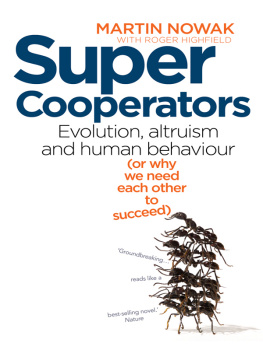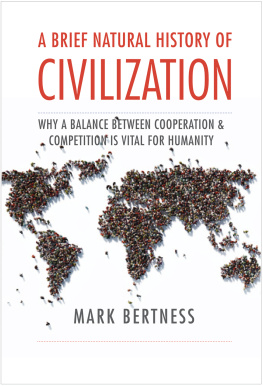Copyright 2013 by Princeton University Press
Published by Princeton University Press,
41 William Street, Princeton, New Jersey 08540
In the United Kingdom: Princeton University Press,
6 Oxford Street, Woodstock, Oxfordshire OX20 1TW
press.princeton.edu
All Rights Reserved
ISBN 978-0-691-15495-4
Library of Congress Cataloging-in-Publication Data
Cronk, Lee.
Meeting at Grand Central : understanding the social and evolutionary roots of cooperation / Lee Cronk and Beth L. Leech.
p. cm.
Includes bibliographical references and i ndex.
ISBN 978-0-691-15495-4 (alk. paper)
1. CooperationHistory.2. Social interactionHistory. I. Leech, Beth L., 1961II. Title.
HD2956.C76 2012
303.3dc23 2012015008
British Library Cataloging-in-Publication Data is available
This book has been composed in Sabon LT
Printed on acid-free paper.
Printed in the United States of America
10 9 8 7 6 5 4 3 2 1
Preface
WE TEACH ON RUTGERS UNIVERSITYS CAMPUS in New Brunswick, New Jersey, located in the southern part of the New York metropolitan area. On September 11, 2001, Beth was scheduled to teach a seminar on citizen activism. The class did not meet that day. Following that mornings terrorist attacks, the university cancelled all classes. When classes resumed the following week, the syllabus called for a discussion of Mancur Olsons writings on the collective action dilemma. Olson, an economist, used a formal model to explain why rational self-interested individuals will not act to achieve their common or group interests. The problem, Olson argued, is that a rational person would instead choose to let someone else do the work while still reaping the benefits. Because this is a problem that every group must face, the class began with the issue of what to do when most people free ride, or choose not to contribute to the common good.
The students were astounded by the very question. What do you mean? they asked. OF COURSE people participate. EVERYONE participates. Just look at what people are doing now in response to the terrorist attacks. And they had a point. Thousands of people volunteered at Ground Zero, where the World Trade Centers twin towers once stood. Many thousands more around the world responded to calls for donations of money and relief supplies, with cash donations by individuals totaling more than $1.5 billion. That generosity was accompanied, particularly in New York City itself, by a refreshing spirit of civility, friendliness, and cooperativeness that lasted for some time after the initial shock of the attacks had subsided.
We are thus faced with a paradox: theory predicts that cooperation will be rare, but everyday experience tells us that it is quite common. This paradox is what drew us to the study of cooperation and inspired us to write this book. Most scholarship to date has focused on only one side or the other of this paradox. Which side any particular scholar focuses on depends largely upon which body of scholarly literature most informs his or her worldview. Social scientists, particularly political scientists, economists, and sociologists, tend to focus on free riding and other obstacles to collective action and how they are sometimes overcome. Scholars with an interest in human evolution, in contrast, tend to be most impressed by how much humans cooperate, particularly with nonrelatives, compared to most other species. We represent both approaches. Beth L. Leech is a political scientist whose work on such topics as interest groups, agenda
Our view is that this paradox is more apparent than real. A full understanding of human cooperation requires an appreciation of both sides of the coin. Although it is true that free riding and other problems often stand in the way of successful collective action, it is also true that people have found a wide variety of ways to overcome and circumvent those problems. Although it is true that humans cooperate with each other much more than do members of most other species, it is also true that humans do a wide range of things much more than any other species: play chess, drive cars, drink coffee, use language, create art, and so on. Our abilities to use language and create art may be the result of selection for those characteristics, but our abilities to drive cars and drink coffee are clearly just by-products of selection for other characteristics. If our high levels of cooperation are the result of selection in favor of characteristics that make cooperation more likely, then we need theories about how those selection pressures would have been felt among our ancestors. However, if some of our species success with cooperation is, like playing chess and driving cars, not the product of selection for cooperation specifically but rather the outgrowth of other characteristics that were favored by selection, then we may not need special theories to explain it. Reality is probably some mix of these two extreme possibilities.
Furthermore, comparing human cooperation levels with those found in other species is not necessarily the most appropriate way to put human cooperation in perspective. A better comparison might be between the real and the ideal: What proportion of situations in which people could benefit from cooperating with each other actually result in cooperation? Despite how much we cooperate, it may be that we actually do so far less often than we could if only we were better at overcoming the collective action dilemma or coordinating our social behaviors. Claims that cooperation is either rare or common inevitably come up against a kind of epistemological roadblock: We know only about the instances in which people at least tried to cooperate. We know nothing about the instances in which people might have benefited from cooperation but were unaware of either the potential to benefit or the best way to go about it. The deck is stacked in favor of the conclusion that humans are great cooperators.
In the chapters that follow, we address these issues and many others related to human cooperation and how it is studied. Our hope is to foster a common cultureshared terminologies, concepts, and theoretical insightsamong the diverse range of scholars who study cooperation and their students.
The first step we took toward this book came in the spring of 2007, when we cotaught an interdisciplinary graduate seminar on cooperation and collective action. We would like to thank the students in that seminar for our many stimulating discussions. During the 20089 academic year, we were on leave in Princeton, New Jersey, Lee at the Institute for Advanced Study and Beth at both IAS and the Center for the Study of Democratic Politics at Princeton Universitys Woodrow Wilson School of Public and International Affairs. We would like to thank both institutions for their generous support and for creating an atmosphere that was both stimulating and contemplative. We would especially like to thank our host at IAS, Eric Maskin, and Beths host at CSDP, Larry Bartels, who coincidentally both got us thinking about how strategic voting is a kind of cooperation. We would also like to acknowledge Rutgers Universitys willingness to allow us to take the year off teaching so that we could take advantage of those opportunities. In Lees case, Rutgers contributed some additional funding to make this possible.












